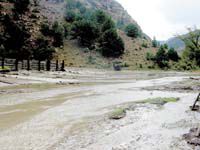| Waters rush down and erode the newly paved section of road running along the Nine Mile Ranch. |
More deaths occur annually due to flooding than from other thunderstorm or hurricane related hazards, according to the United States National Weather Service.
Local people got a taste of the rain’s destructive power on Sept. 5 as a torrential downpour threatened property and personnel safety in Nine Mile Canyon.
“Water came out of three canyons and hit us here at Nine Mile Ranch,” said owner and operator Myrna Mead during an Sept. 6 interview. “A seven-foot wall of water, taller than our truck, came right at our home.”
According to Mead, the storm within the canyon lasted for more than two hours, indicated Mead. If a drainage ditch and elevation change in the front yard had not been in the path of the rushing water, the situation’s outcome could have been worse.
“We had some campers here at the ranch that have been staying for about two months,” said Mead. “And as soon as I could get out of my house, I rushed out to warn them. The flood had dissipated, but was still rushing around my knees. But I got down there, warned them and they were able to get their trucks and four-wheelers out of the storm’s path.”
The ranch’s horses were spooked and there was some property damage.
But according to Mead, the residents of Nine Mile Ranch feel lucky that no one was seriously injured.
The national weather agency reports that many casualties resulting from flash flooding are directly related to careless or unsuspecting motorists who attempt to navigate flooded roads.
The weather service warns motorists coming to a flooded roadway to: “Turn around, don’t drown.”
The federal agency provides safety rules for people who are caught in flash flood waters.
| Flash flood water floods the basement of the Nine Mile Ranch. The Mead family who owns the property suffered significant damage during the storm. |
Carbon County residents should:
•Get to higher ground. Stay away from flood prone areas, including dips, low spots, valleys, ditches and washes.
•Avoid flooded areas or places with rapid water flow.
People should never attempt to cross a rapidly flowing stream.
It takes only six inches of fast flowing water to sweep people off their feet, cautioned the weather service.
•Never allow children to play near high water, storm drains or ditches. Hidden dangers could lie beneath the water.
•Flooded roads could have significant damage hidden by floodwaters. Never drive through flood waters or on flooded roads. If a vehicle stalls, leave it immediately and seek higher ground. Water only two feet deep can float away most automobiles.
•Do not camp or park a vehicle along streams and washes, particularly when threatening conditions exist.
•Be especially cautious at night when it is harder to recognize flood dangers.
•Monitor national weather service radio or local radio for vital weather related information.
According to weather service data they issued 1,832 flash flood warnings last year alone. These alerts warn the public of flood threats to life and property.
“When these warnings are issued for your area or the moment you realize that a flash flood is imminent, act quickly to save yourself, you may only have seconds,” stated the weather service via their website.
They reported that several factors contribute to flash flooding. The two key elements are rainfall intensity and duration. Intensity is the rate of rainfall and duration is how long the rain lasts. Topography, soil conditions and ground cover can also play an important role. The weather service further explains that most flash floods are caused by slow-moving thunderstorms repeatedly moving over the same area.
“When a flood watch is issued be alert to signs of flash flooding and be ready to evacuate at a moments notice,” stated the weather service.
Being trapped in a vehicle when a flash flood hits is a precarious position, according to the weather service.
Mead reported that her friend Wes Noyes was traveling up the canyon in a semi-truck toward Price when he met a wall of water.
“He told us he just shut his eyes as the water raced all the way over the top of his truck,” said Mead. “After the water had subsided he was completely stuck because of all the trapped debris under his vehicle.”
The service recommends the following immediate actions upon learning about a flash flood:
•Get out of the areas subject to flooding. This includes dips, low spots, canyons and washes.
•If driving be aware that the road bed may not be intact under flood waters. Turn around and go another way. Never drive though flooded roads or low water crossings.
•Be cautious at night when flooding is hard to recognize.
•Choose camp sites along waterways with care. Remember that storms that are miles away may bring raging water.
“It is one of the scariest experiences I have ever been though,” said Mead. “When the flood is coming it sounds just like a jet flying right over the top of your ears. It was so loud at one point that I just covered my ears and hoped for the best.”

